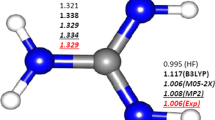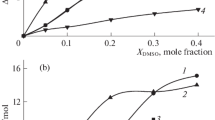Abstract
The characteristics of the interaction of microhydrated guanidinium cation with the aromatic moieties present in the aromatic amino acids side chains have been studied by means of computational methods. The most stable minima found for non-hydrated complexes correspond in all cases to structures with guanidinium oriented toward the ring and interacting by means of N-H···π hydrogen bonds. The interaction becomes stronger when going from benzene (−14 kcal mol−1) to phenol (−17 kcal mol−1) to indole (−21 kcal mol−1). These complexes are held together mainly by electrostatics, but with important contributions from induction and dispersion. The presence of a small number of water molecules significantly affects the characteristics of the complexes. Hydrogen bonds formed by water with the cation, another water molecule, or the aromatic units become more and more similar in intensity as water molecules are included in the complex, leading to a great variety of minima with similar stability but showing very different structural patterns. The behavior is similar with the three aromatic units, the differences in stability mainly being a consequence of the different strength of the cation···π contact.






Similar content being viewed by others
References
Hobza P, Zaradnik R (1988) Intermolecular complexes: the role of van der Waals systems in physical chemistry and the biodisciplines. Elsevier, Amsterdam
Meyer EA, Castellano RK, Diederich F (2003) Interactions with aromatic rings in chemical and biological recognition. Angew Chem Int Ed 42:4120. doi:10.1002/anie.200390574
Salonen LM, Ellermann M, Diederich F (2011) Aromatic rings in chemical and biological recognition: energetics and structures. Angew Chem Int Ed Engl 50:4808–4842. doi:10.1002/anie.201007560
Waters ML, Waters ML (2004) Aromatic interactions in peptides: impact on structure and function. Biopolymers (Pept Sci) 76:435–445. doi:10.1002/bip.20144
Ma JC, Dougherty DA (1997) The cation−π interaction. Chem Rev 97:1303–1324. doi:10.1021/cr9603744
Dougherty DA (2013) The cation-π interaction. Acc Chem Res 46:885–893. doi:10.1021/ar300265y
Mahadevi AS, Sastry GN (2013) Cation-π interaction: its role and relevance in chemistry, biology, and material science. Chem Rev 113:2100–2138. doi:10.1021/cr300222d
Dougherty DA (2007) Cation- π interactions involving aromatic. J Nutr 137:1504S–1508S
Carrazana-Garcia JA, Rodriguez-Otero J, Cabaleiro-Lago EM (2011) DFT Study of the interaction between alkaline cations and molecular bowls derived from fullerene. J Phys Chem B 115:2774–2782. doi:10.1021/jp109654e
Soteras I, Orozco M, Luque FJ (2008) Induction effects in metal cation-benzene complexes. Phys Chem Chem Phys 10:2616–2624
Gallivan JP, Dougherty DA (2000) A computational study of cation-π interactions vs salt bridges in aqueous media: Implications for protein engineering. J Am Chem Soc 122(5):870–874
Anderson MA, Ogbay B, Arimoto R, Sha W, Kisselev OG, Cistola DP, Marshall GR (2006) Relative strength of cation-π vs salt-bridge interactions: The Gtα(340–350) Peptide/Rhodopsin System. J Am Chem Soc 128:7531–7541. doi:10.1021/ja058513z
Hughes RM, Waters ML (2005) Influence of N-methylation on a cation- π interaction produces a remarkably stable β-hairpin peptide. J Am Chem Soc 127:6518–6519. doi:10.1021/ja0507259
Hughes RM, Waters ML (2006) Arginine methylation in a β-hairpin peptide: implications for Arg-π interactions, ΔCp° and the cold denatured state. J Am Chem Soc 128:12735–12742. doi:10.1021/ja061656g
Hughes RM, Waters ML (2006) Effects of lysine acetylation in a β-hairpin peptide: comparison of an amide-π and a cation-π interaction. J Am Chem Soc 128:13586–13591. doi:10.1021/ja0648460
Hughes RM, Benshoff ML, Waters ML (2007) Effects of chain length and N-methylation on a cation- π interaction in a β-hairpin peptide. Chemistry 13:5753–5764. doi:10.1002/chem.200601753
Berry BW, Elvekrog MM, Tommos C (2007) Environmental modulation of protein cation- π interactions. J Am Chem Soc 129:5308–5309. doi:10.1021/ja068957a
Khandelia H, Kaznessis YN (2006) Cation−π interactions stabilize the structure of the antimicrobial peptide indolicidin near membranes: Molecular dynamics simulations. J Phys Chem B 111:242–250. doi:10.1021/jp064776j
Shi Z, Olson CA, Kallenbach NR (2002) Cation−π interaction in model α-helical peptides. J Am Chem Soc 124:3284–3291. doi:10.1021/ja0174938
Mason PE, Dempsey CE, Neilson GW, Kline SR, Brady JW (2009) Preferential interactions of guanidinum ions with aromatic groups over aliphatic groups. J Am Chem Soc 131:16689–16696. doi:10.1021/ja903478s
Tatko CD, Waters ML (2003) The geometry and efficacy of cation – π interactions in a diagonal position of a designed β -hairpin. Protein Sci 12(11):2443–2452. doi:10.1110/ps.03284003
Cabaleiro-Lago EM, Rodriguez-Otero J, Pena-Gallego A (2011) Effect of microhydration on the guanidinium···benzene interaction. J Chem Phys 135:214301
Rodriguez-Sanz AA, Carrazana-Garcia J, Cabaleiro-Lago EM, Rodriguez-Otero J (2013) Effect of stepwise microhydration on the methylammonium···phenol and ammonium···phenol interaction. J Mol Model 19:1985–1994. doi:10.1007/s00894-012-1579-9
Adamo C, Berthier G, Savinelli R (2004) Solvation effects on cation– π interactions: a test study involving the quaternary ammonium ion. Theor Chem Accounts Theory, Comput Model (Theor Chim Acta) 111:176–181. doi:10.1007/s00214-003-0507-6
Xu Y, Shen J, Zhu W, Luo X, Chen K, Jiang H (2005) Influence of the water molecule on cation−π interaction: ab initio Second Order Møller−Plesset Perturbation Theory (MP2) calculations. J Phys Chem B 109:5945–5949. doi:10.1021/jp044568w
Reddy AS, Zipse H, Sastry GN (2007) Cation−π interactions of bare and coordinatively saturated metal ions: contrasting structural and energetic characteristics. J Phys Chem B 111:11546–11553. doi:10.1021/jp075768l
Campo-Cacharron A, Cabaleiro-Lago EM, Rodriguez-Otero J (2012) Effects of microhydration on the characteristics of cation-phenol complexes. Theor Chem Accounts 131:1–13. doi:10.1007/s00214-012-1290-z
Vaden TD, Lisy JM (2004) Characterization of hydrated Na+(phenol) and K+(phenol) complexes using infrared spectroscopy. J Chem Phys 120:721–730. doi:10.1063/1.1630962
Zhao Y, Truhlar DG (2007) The M06 suite of density functionals for main group thermochemistry, thermochemical kinetics, noncovalent interactions, excited states, and transition elements: two new functionals and systematic testing of four M06-class functionals and 12 other function. Theor Chem Acc 120:215–241. doi:10.1007/s00214-007-0310-x
Singh NJ, Min SK, Kim DY, Kim KS (2009) Comprehensive energy analysis for various types of π-interaction. J Chem Theory Comput 5:515–529. doi:10.1021/ct800471b
Tsuzuki S, Uchimaru T (2006) Magnitude and physical origin of intermolecular interactions of aromatic molecules: recent progress of computational studies. Curr Org Chem 10:745–762
Hohenstein EG, Sherrill CD (2012) Wavefunction methods for noncovalent interactions. Wiley Interdiscip Rev Comput Mol Sci 2:304–326. doi:10.1002/wcms.84
Sherrill CD (2009) Computations of noncovalent π interactions. Rev Comput Chem 26:1–38
Grimme S (2003) Improved second-order Møller–Plesset perturbation theory by separate scaling of parallel- and antiparallel-spin pair correlation energies. J Chem Phys 118:9095. doi:10.1063/1.1569242
Hill JG, Platts JA (2007) Spin-component scaling methods for weak and stacking interactions. J Chem Theory Comput 3:80–85. doi:10.1021/ct6002737
Boys SF, Bernardi F (1970) The calculation of small molecular interactions by the differences of separate total energies. Some procedures with reduced errors. Mol Phys 19:553–566. doi:10.1080/00268977000101561
Chałasiński G, Szczȩśniak MM (2000) State of the art and challenges of the ab initio theory of intermolecular interactions. Chem Rev 100:4227–4252. doi:10.1021/cr990048z
Jeziorski B, Moszynski R, Szalewicz K (1994) Perturbation theory approach to intermolecular potential energy surfaces of van der Waals complexes. Chem Rev 94:1887–1930. doi:10.1021/cr00031a008
Sherrill CD (2013) Energy component analysis of π interactions. Acc Chem Res 46:1020–1028. doi:10.1021/ar3001124
Misquitta AJ, Szalewicz K (2005) Symmetry-adapted perturbation-theory calculations of intermolecular forces employing density-functional description of monomers. J Chem Phys 122:214109. doi:10.1063/1.1924593
Hesselmann A, Jansen G, Schütz M (2005) Density-functional theory-symmetry-adapted intermolecular perturbation theory with density fitting: a new efficient method to study intermolecular interaction energies. J Chem Phys 122:14103. doi:10.1063/1.1824898
Werner H-J, Knowles PJ, Knizia G, Manby FR, Schütz M, Celani P, Korona T, Lindh R, Mitrushenkov A, Rauhut G, Shamasundar KR, Adler TB, Amos RD, Bernhardsson A, Berning A, Cooper DL, Deegan MJO, Dobbyn AJ, Eckert F, Goll E, Hampel C, Hesselmann A, Hetzer G, Hrenar T, Jansen G, Kö C, Liu Y, Lloyd AW, Mata RA, May AJ, McNicholas SJ, Meyer W, Mura ME, Nicklaß A, O’Neill DP, Palmieri P, Peng D, Pitzer KP, Reiher M, Shiozaki T, Stoll H, Stone AJ, Tarroni R, Thorsteinsson T, Wang M (2009) Molpro version 2009.1, a package of ab initio programs. see http://www.molpro.net
Frisch MJ, Trucks GW, Schlegel HB, Scuseria GE, Robb MA, Cheeseman JR, Scalmani G, Barone V, Mennucci B, Petersson GA, Nakatsuji H, Caricato M, Li X, Hratchian HP, Izmaylov AF, Bloino J, Zheng G, Sonnenberg JL, Hada M, Ehara M, Toyota K, Fukuda R, Hasegawa J, Ishida M, Nakajima T, Honda Y, Kitao O, Nakai H, Vreven T, Montgomery, J. A. J, Peralta JE, Ogliaro F, Bearpark M, Heyd JJ, Brothers E, Kudin KN, Staroverov VN, Kobayashi R, Normand J, Raghavachari K, Rendell A, Burant JC, Iyengar SS, Tomasi J, Cossi M, Rega N, Millam NJ, Klene M, Knox JE, Cross JB, Bakken V, Adamo C, Jaramillo J, Gomperts R, Stratmann RE, Yazyev O, Austin AJ, Cammi R, Pomelli C, Ochterski JW, Martin RL, Morokuma K, Zakrzewski VG, Voth GA, Salvador P, Dannenberg JJ, Dapprich S, Daniels AD, Farkas Ö, Foresman JB, Ortiz JV, Cioslowski J, Fox DJ (2009) Gaussian 09, revision A.02
Kim D, Hu S, Tarakeshwar P, Kim KS, Lisy JM (2003) Cation - π interactions: a theoretical investigation of the interaction of metallic and organic cations with alkenes, arenes, and heteroarenes. J Phys Chem A 1228–1238
Acknowledgments
The authors thank the financial support from the Ministerio de Ciencia e Innovación and the European Regional Development Fund (ERDF) 2007–2013 (Grant No. CTQ2009-12524). We are also thankful to the Centro de Supercomputación de Galicia (CESGA) for the use of their computers. A. A. R.-S. also thanks Spanish Ministerio Ciencia e Innovación for a Formación de Personal Investigador (FPI) grant.
Author information
Authors and Affiliations
Corresponding author
Electronic supplementary material
Below is the link to the electronic supplementary material.
ESM 1
(PDF 108 kb)
Rights and permissions
About this article
Cite this article
Rodríguez-Sanz, A.A., Cabaleiro-Lago, E.M. & Rodríguez-Otero, J. Effect of stepwise microhydration on the guanidinium···π interaction. J Mol Model 20, 2209 (2014). https://doi.org/10.1007/s00894-014-2209-5
Received:
Accepted:
Published:
DOI: https://doi.org/10.1007/s00894-014-2209-5




